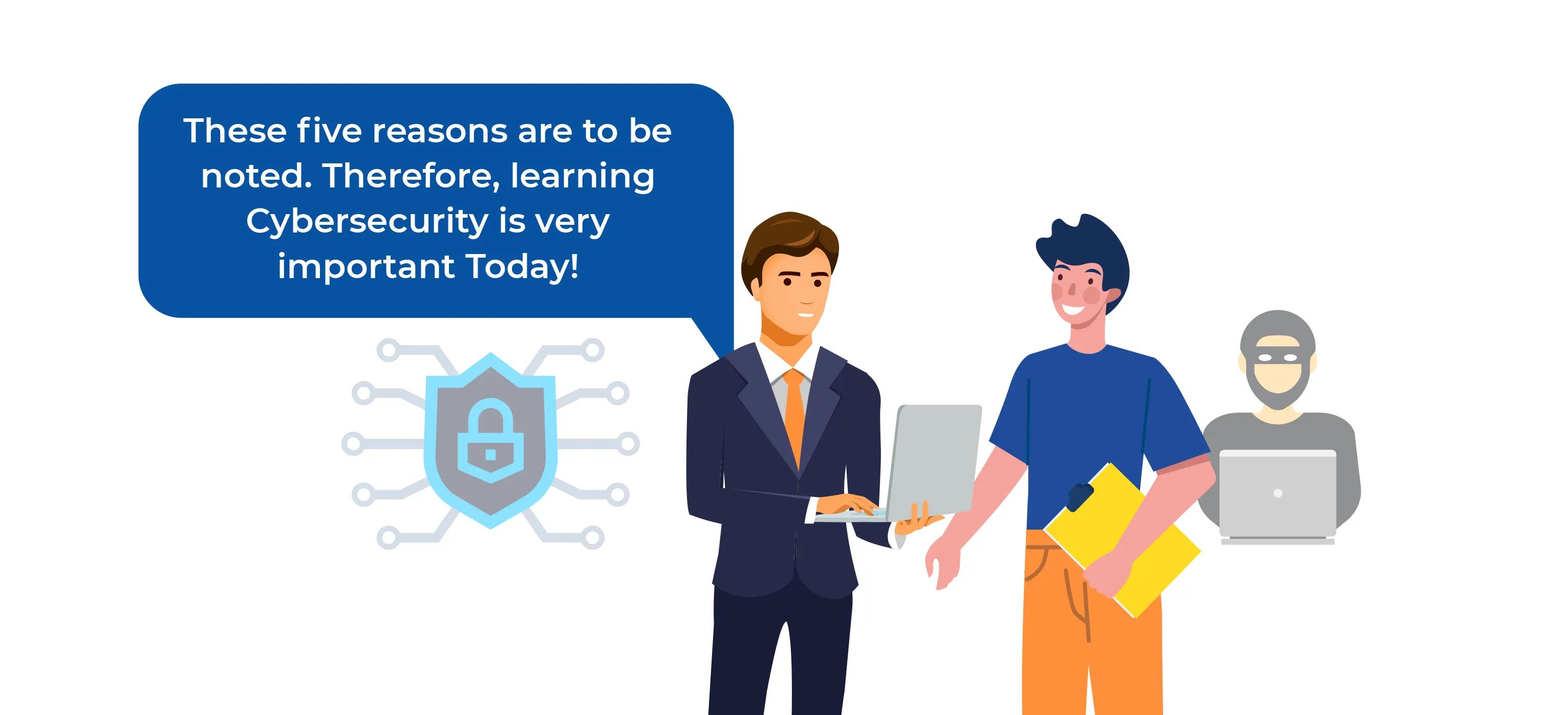 Satendra K
Feb 05, 2025
Satendra K
Feb 05, 2025

Cybersecurity is important today due to the surging cybercrimes, the evolution of sophisticated threats like ransomware, the need to protect sensitive data and the increasing reliance on interconnected devices and the internet.
According to Cybercrime Magazine, “Cybersecurity Ventures expects global cybercrime costs to grow over USD 10.5 trillion annually in 2025”, highlighting the rapid growth of cybercrime.
With every click, every download, and every internet connection, you might be unknowingly opening a Pandora's box of potential cybersecurity breaches. This makes cybersecurity your first and last line of defence!
Cybersecurity is important because it is the process of protecting your systems, networks, and assets from digital threats. Cybersecurity professionals prevent unauthorized access to sensitive information and protect against data breaches. Here are 7 reasons why cybersecurity is important:
Cybersecurity is a continuous process rather than a one-time solution. To better protect your digital assets and organisation from evolving cyber-attacks, consider staying informed about emerging threats, and advanced security technologies. Let's take a look at several reasons why Cybersecurity is the future.
Cloud Adoption is the process of moving an organization's data, applications, and IT resources from traditional on-premises infrastructure to cloud-based services. Today, over 94% of businesses have already migrated to the cloud and embraced remote work. As a result, exposure to cyber risks grows. Securing cloud environments and hybrid work infrastructures becomes critical to prevent data leaks and service disruptions.
One major concern in cloud security is data breaches. In 2013, Yahoo suffered one of the largest data breaches in history. Hackers exploited a weakness in the company's cookie system to access the names, birthdates, email addresses and passwords of all 3 billion Yahoo users.
The rapid adoption of cloud technology also presents challenges, including data sovereignty issues, migration complexities, and a skills gap in the workforce. Misconfigured cloud settings, insecure APIs and poor access controls can also create entry points for hackers. Additionally, multi-tenancy risks arise when multiple users share cloud infrastructure, increasing the chances of cross-tenant attacks.
Digital transactions are the electronic exchange of money or value between parties without physical cash. This is facilitated through digital devices and internet-based platforms.
With the rise of online banking, e-commerce, and digital payments, financial transactions are at higher risk of fraud and cybercrime. Strong cybersecurity protocols are necessary to ensure secure transactions, boosting the importance of cybersecurity in financial technology (FinTech) and beyond.
Not only do donations and businesses face threats from the actions of hackers, but ordinary individuals also have increased exposure to cyber risk. Hackers steal an individual's personal information and sell it for profit. As a result, the data on our mobile, computer and other digital platforms are not safe. For instance, The Equifax data breach of 2017 exposed 147 million personal records, leading to a $425 million settlement.
Cybercriminals target personal information, stealing an individual's sensitive data such as bank account details, credit card numbers, and personal identification information. This not only jeopardizes financial security but can also lead to identity theft and other forms of fraud. As digital transactions become more prevalent, the need for enhanced cybersecurity measures for everyone is more pressing than ever.
Phishing is a cyber-attack where the attacker sends fraudulent communications that appear to come from a reputable source through email. AI-powered phishing attacks utilise artificial intelligence to enhance the sophistication and effectiveness of phishing schemes.
Phishing is one of the most common cyber attacks. The scope of phishing attacks has become massive through the use of AI, and that's just the beginning of the malicious use of machine learning. With enough computing power, scammers could send a phishing message to every person on the planet each day. In addition, AI is helping them create much more believable doppelgängers of legitimate company websites and trusted contacts.
Unfortunately, AI is making these tactics much more effective on a much grander scale, and it's only the beginning. People have to educate themselves on how to spot these communications and second-guess their emotional responses. It's going to be a long, uphill battle for security.
Quantum computing is another game changer. It promises breakthroughs but threatens current encryption methods. Quantum computers could eventually break today's encryption, so organizations should explore quantum-resistant encryption now.
A data breach occurs when unauthorized individuals or entities gain access to sensitive, confidential, or personal information, leading to its exposure, theft, or misuse. Businesses and organisations can't afford a data breach. Data breaches cost businesses an average of $3.62 million—a number that can put many companies out of business. This in an important reason why the cybersecurity field is growing.
According to the reports from Forbes, "the cost of breaches has been consistently rising in the last few years. The new vulnerabilities that emerged from shifting to a remote workforce expanded the cyber-attack surface and added many vulnerabilities for hackers to exploit from home offices. Automated attacks by hackers and the ability to convert cryptocurrencies via ransomware have also added to cybercrimes.
The rise in ransomware activities. Especially after Qakbot was taken down in August, new ransomware programs have started to fill the gaps. Ransomware like Play, Give, LockBit, and DarkGate seem to target more companies each year and intensify their illicit activities. The best way to mitigate this is through cybersecurity training, which helps employees strengthen their baseline understanding of cybersecurity and lessens the likelihood of a cybersecurity incident.
Aren't we all sure that hackers are getting smarter? They find new ways to access data every day. Apart from cyber-attacks such as breach of access, web browser exploits, instant messaging abuse, intellectual property (IP) theft, or unauthorised access, there are newer methods everyday hackers go for. Some of the most concerning modern threats include supply chain attacks, AI-driven malware, and deepfake scams.
Attacks on remote monitoring tools are another leading cyber threat that is beginning to take shape and disrupt the digital sector. These remote monitoring and management (RMM) tools are easy for employees to download to access their work devices remotely, often not even needing proper verification before downloading. This means that hackers can turn a widely available tool into an attack vector. Once they access these platforms, they connect directly with a user's work device, gaining access to its files, documents, and other network resources.
Therefore, it is very crucial to give awareness to people about Cybercrime. Knowledge and implementation of innovative tools and upskilling your cybersecurity teams are essential to empower the safety of your data.
The tactics used by cybercriminals have evolved, and so must cybersecurity professionals. Developing in-demand cybersecurity skills is essential to protect your organization effectively.
|
The cybersecurity workforce is growing fast, but demand for cybersecurity professionals is growing faster. The only solution to all the above-mentioned cybersecurity threats is to hire professional cybersecurity professionals. Recent ISC2 research estimates a 4 million-person workforce gap in the cybersecurity domain.
Gartner Cybersecurity 2024 survey finds that there is a continued gap between security-talent supply and demand. If you want to become a part of the cybersecurity workforce, then there is no better time than now! To become a cyber security professional, you should have a strong foundational knowledge of computer networking and operating systems. You can also start your cybersecurity career with job-relevant certifications like CEH v13 and CompTIA Security+.
This cybersecurity workforce gap is both a crisis and an opportunity. While organizations face heightened risks due to understaffing, individuals entering the field enjoy high salaries, ie with an average salary of $120,000 and job security. The future of cybersecurity careers is promising, offering numerous opportunities for those willing to develop their skills in this critical field. Looking ahead, cybersecurity professionals must continue to adopt proactive defence strategies and focus on cyber resilience by upskilling and keeping pace with emerging threats and technologies.

Chief Technology Officer & Cyber Security Expert Trainer
Satendra Singh Khari is a renowned cybersecurity expert and the Chief Technology Officer at Edoxi, where he leads the CEH v13 AI program. With over 12 years of experience, he has trained more than 10,000 professionals and earned recognition in the Circle of Excellence for 2023 and 2024. Mr. Khari holds multiple industry certifications, including CISSP, CISM, CEH, CPENT, and CREST, which showcase his expertise in vulnerability assessment, penetration testing, and incident handling.
His practical insights, gained during his tenure as Head of Information Security in Malaysia, enhance the learning experience by providing students with essential technical skills and a clear path to career advancement. Recognized as a leader in his field, he has received the Internet 2.0 Outstanding Leadership Award for three consecutive years (2022-2024), reflecting his dedication to empowering the next generation of cybersecurity professionals.